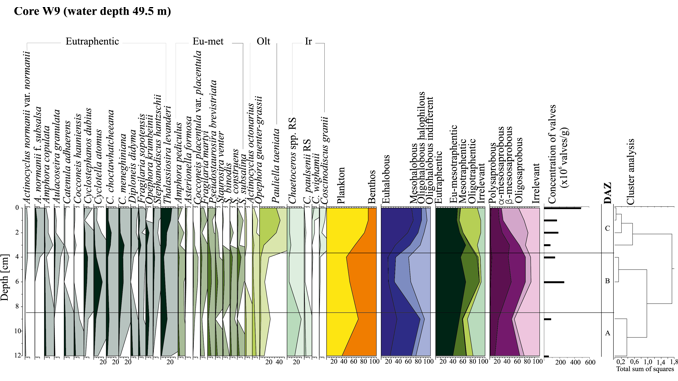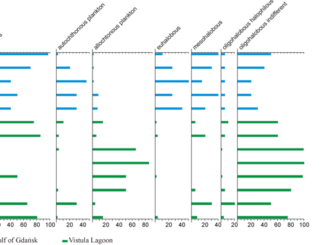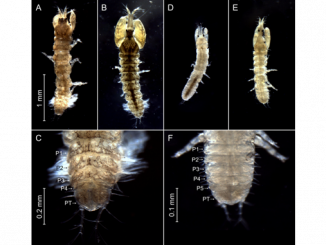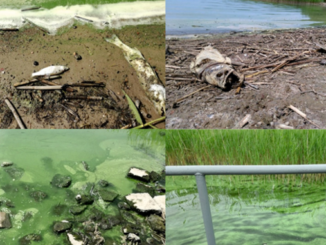
Paper category: Original research paper
Corresponding author: Jarosław Pędziński (jaroslaw.pedzinski@ug.edu.pl)
DOI: 10.2478/ohs-2019-0022
Received: 28/02/2019
Accepted: 06/03/2019
Full text: here
Citation (APA style): Pędziński, J. & Witak, M. (2019). Evidence of cultural eutrophication of the Gulf of Gdańsk based on diatom analysis. Oceanological and Hydrobiological Studies, 48(3), pp. 247-261. Retrieved 3 Oct. 2019, from doi:10.2478/ohs-2019-0022
Abstract
The objective of this study was to reconstruct the environmental changes in the Gulf of Gdańsk in the last 200 years. Four subbottom sediment cores were analyzed with respect to diatom flora and anthropogenic effects. The so-called “anthropogenic assemblage” – a result of cultural eutrophication – was observed in the surface sediments. Changes in the species composition may have been caused by the increased use of fertilizers, nitrogen loads and increasing organic matter concentration. Three phases (A, B and C) were distinguished based on the floristic spectrum, which clearly indicates trophic changes in the study area.
References
Andrén, E. (1999). Changes in the composition of the diatom flora during the last century indicate increased eutrophication of the Oder estuary, southwestern Baltic Sea. Estuarine, Coastal and Shelf Science 48(6): 665–676. DOI: 10.1006/ecss.1999.0480.
Andrén, E., Shimmield, G. & Brand, T. (1999). Environmental changes of the last three centuries indicated by siliceous microfossil records from the southwestern Baltic Sea. The Holocene 9(1): 25–38. DOI: 10.1191/095968399676523977.
Andrén, E., Andrén, T. & Kunzendorf, H. (2000). Holocene history of the Baltic Sea as a background for assessing records of human impact in the sediments of the Gotland Basin. The Holocene 10(6): 687–702. DOI: 10.1191/09596830094944.
Andrulewicz, E., Szymelfenig, M. & Urbański, J. (1998). Morze Bałtyckie – o tym warto wiedzieć. Zeszyty Zielonej Akademii, Zeszyt nr 7. [Baltic Sea – it’s worth knowing about it]. (In Polish).
Andrulewicz, E. & Witek, Z. (2002). Anthropogenic pressure and environmental effects on the Gulf of Gdansk: recent management efforts. In G. Schernewski & U. Schiewer (Eds.), Baltic coastal ecosystems, structure, function and coastal zone management. Central and Eastern European Development Studies (pp. 119–139). Berlin: Springer Verlag.
Arend, K.K., Beletsky, D. & de Pinto, J.V. (2011). Seasonal and interannual effects of hypoxia on fish habitat quality in central Lake Erie. Freshwater Biology 56: 366–383. DOI: 10.1111/j.1365-2427.2010.02504.x.
Battarbee, R.W. (1986). Diatom analysis. In B.E. Berglund (Eds.), Handbook of Holocene Palaeoecology and Palaeohydrology (pp. 527–570). London: John Wiley & Sons Ltd.
Bąk, M. (2004). Changes in species composition of the diatom (Bacillariophyceae) flora of the Szczecin Lagoon (Northern Poland) as a result of long-term inflow of polluted River Odra waters. Unpublished doctoral dissertation, University of Szczecin, Poland (In Polish).
Boesch, D.F. (2002). Challenges and opportunities for science in reducing nutrient over-enrichment of coastal ecosystems. Estuaries 25: 886–900. DOI: 10.1007/BF02804914.
Bodén, P. (1991). Reproducibility in the Random Settling Method for Quantitative Diatom Analysis. Micropaleontology 37(3): 313–319. DOI: 10.2307/1485893.
Bogaczewicz-Adamczak, B. & Dziengo, M. (2003). Using benthic diatom communities and diatom indices to assess water pollution in the Puck Bay (southern Baltic Sea) littoral zone. Oceanological and Hydrobiological Studies 32(4): 131–157.
Carpenter, S.R. (1981). Submersed vegetation: an internal factor in lake ecosystem succession. The American Naturalist 118: 372–383.
Carpenter, S.R., Caraco, N.F., Correll, D.L., Howarth, R.W., Sharpley, A.N. et al. (1998). Nonpoint pollution of surface waters with phosphorus and nitrogen. Ecological Society of America 8(3): 559–568. DOI: 10.2307/2641247.
Clark, R.B. (2001). Marine pollution 5th Ed. Oxford: University Press.
Cloern, J.E. (2001). Our evolving conceptual model of the coastal eutrophication problem. Marine Ecology Progress Series 210: 223–253. DOI: 10.3354/meps210223.
de Jonge, V.N., Elliot, M. & Orive, E. (2002). Causes, historical development, effects and future challenges of a common environmental problem: eutrophication. Hydrobiologia 475/476: 1–19. DOI: 10.1023/A:1020366418295.
Denys, L. (1991). A check-list of the diatoms in the Holocene deposits of the western Belgian coastal plain with a survey of their apparent ecological requirements. I. Introduction, ecological code and complete list. Professional Paper Belgium Geological Survey 246: 1–41.
Diaz, R.J. & Rosenberg, R. (1995). Marine benthic hypoxia: a review of its ecological effects and the behavioural responses of benthic macrofauna. Oceanography and Marine Biology. Annual Review 33: 245–303.
Elmgren, R. & Larsson, U. (2001). Eutrophication in the Baltic Sea area: integrated coastal management issues. In B. von Bodungen & R.K. Turner (Eds.), Science and integrated coastal management, (pp. 15–35). Berlin: University Press.
Glasby, G.P. & Szefer, P. (1998). Marine Pollution in Gdańsk Bay, Puck Bay and the Vistula Lagoon, Poland, an overview. The Science of the Total Envronment 212(1): 49–57. DOI: 10.1016/S0048-9697(97)00333-1.
Grimm, E.C. (2011). Tilia Version 1.7.16 (software). Springfield, IL: Illinois State Museum.
Grimm, K.A. & Gill, A.S. (1994). Fossil phytoplankton blooms and selfish genes: the ecological and evolutionary significance of Chaetoceros resting spores in laminated diatomaceous sediments. Geological Society of America Abstract with Programs 26(6): 170–171.
Haecky, P., Jonsson, S. & Andersson, A. (1998). Influence of sea ice on the composition of the spring phytoplankton bloom in the northern Baltic Sea. Polar Biol. 20:1– 8.
Hajdu, S. & Larsson, U. (1990). Spatial and temporal Patterns in succession of pelagic diatoms in a brackich water coastal area. In 11th International Symposium on Living and Fossil Diatoms, 13–17 August 1990 (pp. 39). San Francisco.
Håkanson, L. & Bryhn, A.C. (2008). Eutrophication in the Baltic Sea; Present situation, Nutrient transport, Processes, Remedial strategies. Environmental Science and Engineering. Berlin, Heidelberg: Springer-Verlag.
Hasle, G.R. & Syvertsen, E.E. (1997). Marine diatoms. In C.R. Tomas (Eds.), Identifying marine phytoplankton (pp. 5–385). San Diego: Academic Press.
Heisler, J., Glibert, P.M., Burkholder, J.M., Andreson, D.M., Cochlan, W. et al. (2008). Eutrophication and harmful algal blooms: A scientific consensus. Harmful Algae 8: 3–13. DOI: 10.1016/j.hal.2008.08.006.
HELCOM. (2002). Environment of the Baltic Sea area 1994–1998. Baltic Sea Environ. Proc. No. 82B.
HELCOM Ministerial Meeting. (2007). Towards a Baltic Sea unaffected by eutrophication. Kraków, 15 November 2007.
Höglander, H., Larsson, U. & Hajdu, S. (2004). Vertical distribution and settling of spring phytoplankton in the offshore NW Baltic Sea proper. Marine Ecology Progress Series. 283: 15–27. DOI: 10.3354/meps283015.
Hustedt, F. (1927–1966). Die Kieselalgen Deutschlands, Österreichs und der Schweiz 1–3. In L. Rabenhorsts (Ed.), Kryptogamen flora von Deutschland, Österreich und der Schweiz 7. Leipzig: Akademische Verlerlagsbuchhandlung.
Kowalkowski, T., Pastuszak, M., Igras, J. & Boguszewski, B. (2012). Differences in emission of nitrogen and phosphorus into the Vistula and Oder basins in 1995–2008 – Natural and anthropogenic causes (MONERIS model). Journal of Marine Systems 89(1): 48–60. DOI: 10.1016/j.jmarsys.2011.07.011.
Krammer, K. & Lange-Bertalot, H. (1986). Bacillariophyceae. 1. Teil: Naviculaceae. In H. Ettl, J. Gerloff, H. Heynig & D. Mollenhauer (Eds.), Süßwasserflora von Mitteleuropa 2/1. Stuttgart & New York: G. Fischer.
Krammer, K. & Lange-Bertalot, H. (1988). Bacillariophyceae. 2. Teil: Bacillariaceae, Epithemiaceae, Surirellaceae. In H. Ettl, J. Gerloff, H. Heynig & D. Mollenhauer (Eds.), Süßwasserflora von Mitteleuropa 2/2. Stuttgart & New York: G. Fischer.
Krammer, K. & Lange-Bertalot, H. (1991a). Bacillariophyceae. 3.Teil: Centrales, Fragilariaceae, Eunotiaceae. In H. Ettl, J. Gerloff, H. Heynig & D. Mollenhauer (Eds.), Süßwasserflora von Mitteleuropa 2/3. Stuttgart & Jena: G. Fischer.
Krammer, K. & Lange-Bertalot, H. (1991b). Bacillariophyceae. 4.Teil: Achnanthaceae. Kritische Ergänzungen zu Navicula (Lineolatae) und Gomphonema. Gesamtliteraturverzeichnis. In H. Ettl, J. Gerloff, H. Heynig & D. Mollenhauer (Eds.), Süßwasserflora von Mitteleuropa 2/4. Stuttgart & Jena: G. Fischer.
Kruk-Dowgiałło, L. (1996) The role of filamentous brown algae in the degradation of the underwater meadows the Gulf of Gdańsk. Oceanological Studies. 25: 125–137.
Larsson, U., Elmgren, R. & Wulff, F. (1985). Eutrophication and the Baltic Sea: causes and consequences. Ambio 14: 9–14.
Lehtiniemi, M., Engström-Öst, J. & Viitasalo, M. (2005). Turbidity decreases anti-predator behaviour in pike larvae, Esox Lucius. Environmental Biology of Fishes 73: 1–8. DOI: 10.1007/s10641-004-5568-4.
Leśniewska, M. & Witak, M. (2008). Holocene diatom biostratigraphy of the SW Gulf of Gdańsk, Southern Baltic Sea (part III). Oceanological and Hydrobiological Studies. 37(4): 35–52. DOI: 10.2478/v10009-008-0017-x.
Leśniewska, M. & Witak, M. (2011). Diatoms as indicators of eutrophication in the western part of the Gulf of Gdańsk, Baltic Sea. Oceanological and Hydrobiological Studies. 40(1): 68–81. 10.2478/s13545-011-0008-5.
Łysiak-Pastuszak, N. Drgas, E. & Piątkowska, Z. (2004). Eutrophication in the Polish coastal zone: the past, present status and future scenarios. Mar. Poll. Bull. 49: 186–195. DOI: 10.1016/j.marpolbul.2004.02.007.
Mazur-Marzec, H., Krężel, A., Kobos, J. & Pliński, M. (2006). Toxic Nodularia spumigena blooms in the coastal waters of the Gulf of Gdańsk: a ten-year survey. Oceanologia 48(2): 255–273.
Mazur-Marzec, H. & Pliński, M. (2009). Do toxic cyanobacteria blooms pose a threat to the Baltic ecosystem? Oceanologia 51(3): 293–319. DOI:10.5697/oc.51-3.293.
Mazur-Marzec, H., Sutryk, K., Kobos, J., Hebel, A., Hohlfeld, N. et al. (2012). Occurrence of cyanobacteria and cyanotoxin in the Southern Baltic Proper. Filamentous cyanobacteria versus single-celled picocyanobacterial. Hydrobiologia 701: 235–252. DOI: 10.1007/s10750-012-1278-7.
Nixon, S.W. (1995). Coastal marine eutrophication: A definition, social causes, and future concerns. Ophelia 41: 199–219. DOI: 10.1016/j.marpolbul.2004.02.007.
Olenina, I. & Kavolyte, R. (1997). Phytoplankton, chlorophyll a and the environmental conditions in the southeastern coastal zone of the Baltic Sea. In A. Andrusaitis (Ed.), Proc. 13th Baltic Marine Biologists, Inst. Aquatic Ecology, University of Latvia (pp. 53–61).
Österblom, H., Hansson, S., Larsson, U. Hjerne, O., Wulff, F., Elmgren, R. & Folke, C. (2007). Human-induced Trophic Cascades and Ecological Regime Shifts in the Baltic Sea. Ecosystems 10(6): 877–889. DOI: 10.1007/s10021-007-9069-0.
Pankow, H. (1990). Ostsee-Algenflora. Jena: Fischer.
Paerl, H.W. (2009). Controlling eutrophication along freshwater marine continuum: dual nutrient (N and P) reductions are essential. Estuaries and Coasts 32: 593–601. DOI: 10.1007/s12237-009-9158-8.
Pastuszak, M., Stålnacke, P., Pawlikowski, K. & Witek, Z. (2012). Response of Polish rivers (Vistula, Oder) to reduced pressure from point sources and agriculture during the transition period (1988–2008). Journal of Marine Systems (94): 157–173. DOI: 10.1016/j.jmarsys.2011.11.017.
Pliński, M. (1979). Kierunki zmian strukturalnych w fitoplanktonie estuariów Bałtyku Południowego. Rozprawy i monografie UG. 15: 1–136. (In Polish).
Schernewski, G. & Neumann, T. (2005). The trophic state of the Baltic Sea a century ago: a model simulation study. Journal of Marine Systems. 53: 109–124. DOI: 10.1016/j.jmarsys.2004.03.007.
Schindler, D.W. (2006). Recent advances in the understanding and management of eutrophication. Limnology and Oceanography 51: 356–363. DOI: 10.4319/lo.2006. 51.1_part_2.0356.
Schrader, H. & Gersonde, R. (1978). Diatoms and silicofiagellates in the eight meters sections of the lower Pleistocene at Capo Rossello. Utrecht Micropaleontological Bulletin 17: 129–176.
Smith, V.H. & Schindler, D.W. (2009). Eutrophication science: where do we go from here? Trends in Ecology & Evolution. 24(4): 201–7. DOI: 10.1016/j.tree.2008.11.009.
Stålnacke, P. (1996). Nutrient loads to the Baltic Sea. Unpublished doctoral dissertation, University of Linköping, Sweden.
Stachura-Suchoples, K. (1999). Okrzemki jako wskaźniki oddziaływania Wisły na paleoekologię Zatoki Gdańskiej [Diatoms as indicators of Vistula River influence on the paleoecology of the Gulf of Gdańsk]. Unpublished doctoral dissertation, University of Gdańsk. (In Polish).
Stachura-Suchoples, K. (2001). Bioindicative values of dominant diatom species from the Gulf of Gdańsk, Southern Baltic Sea, Poland. In R. Jahn, J.P. Kociolek, A. Witkowski & P. Compère (Eds.), Lange-Bertalot-Festschrift Studies on diatoms (pp. 477–490). Rugell: A.R.G. Gantner Verlag K.G.
Turner, A.M. & Chislock, M.F. (2010). Blinded by the stink: Nutrient enrichment impairs the Perception of predation risk by freshwater snails. Ecological Applications 20(8): 2089–2095. DOI: 10.1890/10-0208.1.
Tuovinen, N., Weckström, K. & Virtasalo, J. (2010). Assessment of recent eutrophication and climate influence in the Archipelago Sea based on the subfossil diatom record. Journal of Paleolimnology 44: 95–108. DOI: 10.1007/s10933-009-9390-z.
van Dam, H., Mertens, A. & Sinkeldam, J. (1994). A coded checklist and ecological indicator values of freshwater diatoms from the Netherlands. Netherlands Journal of Aquatic Ecology 28: 117–133.
Vos, P.C. & de Wolf, H. (1993). Diatoms as a tool for reconstructing sedimentary environments in coastal wetlands; methodological aspects. Hydrobiologia 269/270: 285–296.
Voss, M., Dippner, J.W., Humborg, C., Hürdler, J., Korth, F. et al. (2011). History and scenarios of future development of the Baltic Sea eutrophication. Estuarine. Coastal and Shelf Science 92(3): 307–322. DOI: 10.1016/j. ecss.2010.12.037.
Wassmann, P. & Olli, K. (2004). Drainage basin nutrient inputs and eutrophication: an integrated approach. Norway: University of Tromsø.
Witak, M. (2000). A diatom record of late Holocene environmental changes in the Gulf of Gdańsk. Oceanological Studies 29(2): 57–74.
Witak, M. (2010). Application of diatom biofacies in reconstructing the evolution of sedimentary basins. Records from the southern Baltic Sea differentiated by the extent of the Holocene marine transgressions and human impact, Diatom Monographs 12, Ruggell, Liechtenstein: A.R.G. Gantner Verlag K.G.
Witak, M., Jankowska, D. & Piekarek-Jankowska, H. (2006). Holocene diatom biostratigraphy of the SW Gulf of Gdańsk, Southern Baltic Sea (part I). Oceanological and Hydrobiological Studies 35(4): 307–329.
Witak, M., Pędziński, J. (2018). The diatom record of progressive anthropopressure in the Gulf of Gdańsk and the Vistula Lagoon. Oceanological and Hydrobiological Studies 47(2): 167–180. DOI: 10.1515/ohs-2018-0016.
Witkowski, A. (1994). Recent and fossil diatom flora of the Gulf of Gdańsk, Southern Baltic Sea. Biblitheca Diatomologica 28: 1–313.
Witkowski, A. & Pempkowiak, J. (1995). Reconstructing the development of human impact from diatoms and 210Pb sediment dating (the Gulf of Gdańsk – southern Baltic Sea). Geographica Polonica 65: 63–78.
Witkowski, A., Lange-Bertalot, H. & Metzeltin, D. (2000). Diatom flora of marine costs I. Iconographica Diatomologica 7: 1–925.
Wulff, F., Savchuk, O.P., Sokolov, A., Humborg, C. & Mörth, C.M. (2007). Management options and effects on a marine ecosystem: assessing the future of the Baltic. Ambio 36: 243–249.




Bądź pierwszy, który skomentuje ten wpis